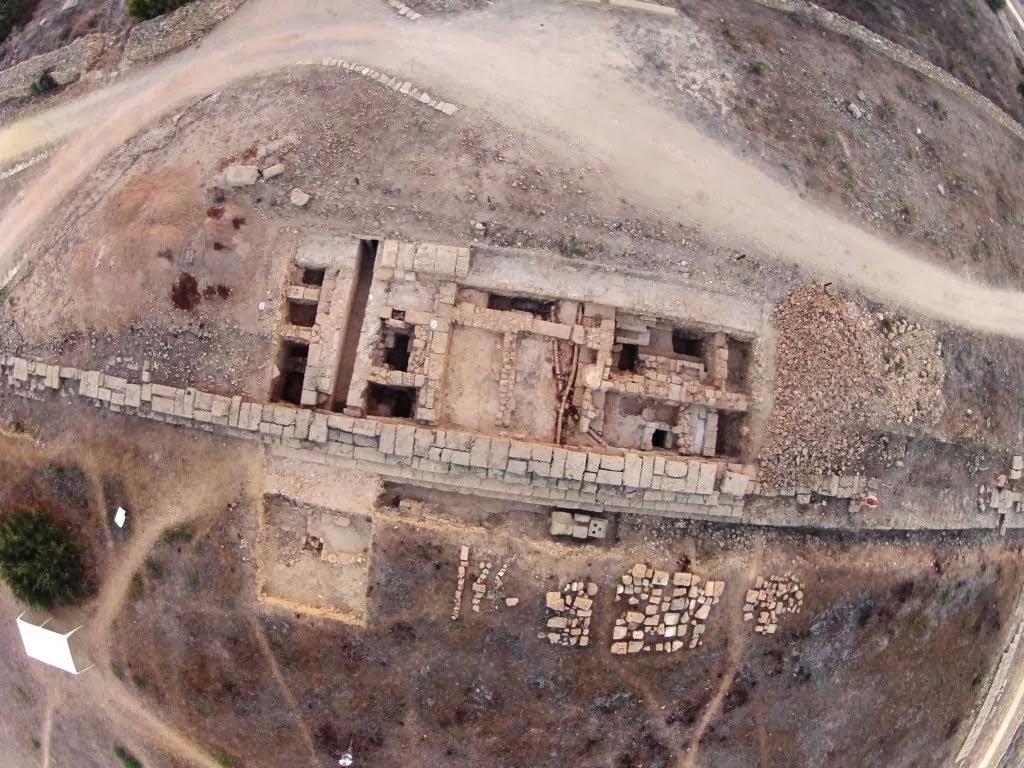
Excavations of the Paphos Agora Project 2013
The third season (2013) of excavations of the Department of Classical Archaeology of the Institute of Archaeology, Jagiellonian University (JU), Kraków, Poland, was conducted within the framework of the Paphos Agora Project, which aims at the exploration of the Agora of the ancient city of Nea Paphos, the capital of Cyprus in the Hellenistic and Roman periods.
 |
| Nea Paphos Agora: Aerial view of Trench II made with quadrocopter [Credit: M. Rajwa] |
The exploration work of the 2013 season was conducted between the 12th of August and the 20th of September. The team, led by Professor Ewdoksia Papuci-Władyka comprised nearly 40 members, including the staff of the Institute, doctoral students, graduate and undergraduate students and volunteers. The aim of the campaign was not only to excavate but also to carry out conservation of metal artefacts discovered during the previous seasons and kept in the Paphos District Museum. Of particular importance was the cleaning of coins, which – together with pottery – are key elements for the chronology of excavated architecture and other objects.
Excavations were conducted in Trench II, which continues ever since the first season. This trench is located in the central part of the eastern portico of the Agora, by the entrance to the square from the east. This year it was extended to the south, where new rooms were uncovered; the total number of rooms uncovered reached 15. A majority of them had been most likely shops (tabernae) situated close to the eastern entrance of the Roman Agora. In the northern part of Trench II exploration was completed in rooms 6 and 7, after having reached bedrock. Architectural structures (walls, floors, etc.) were uncovered, dating most probably to the Hellenistic and Early Roman periods.
Work was also conducted in the southern part within rooms 3 and 5, where work began last year, and in the newly uncovered rooms 13-15. Architectural remains belonging to several building phases were found: Phase I – Hellenistic period; Phase II – rebuilding in the time of Augustus, probably after the large earthquake in 15 BC, when the first phase of the Roman Agora portico was constructed; Phase III – rebuilding after the earthquake in the 70s AD; Phase IV – rebuilding after the earthquake in the time of Hadrian, when the last phase of the Agora portico was constructed, representing what can be seen today on entering the Agora. The chronology given above is only provisional, and needs to be corroborated by pottery, coins and further study of the material found.
The exploration results in Room 13 were particularly interesting. Here, the earliest structure uncovered so far is a cistern with a rectangular entrance. It appears that the cistern is earlier than the earliest phase of the eastern portico of the Agora, and should probably date to the Hellenistic period, as indicated by pottery and coins. When the foundations of the eastern portico of the Agora had been built, most likely in the time of Augustus, the western wall of the cistern was disassembled; later it was reconstructed in a different technique and it formed part of the portico foundations.
In the 2013 season a new trench (Trench III) not far from the southern portico of the Agora, to its north, so as to check whether there had been any structures earlier than the Roman Agora at this point. Ten walls, fragments of two floors and other architectural structures were uncovered. The analysis of the pottery found in the lowest layers by the walls indicates that some of these structures were in use in the Hellenistic period, and were covered by a thick layer of fill of Roman date. At present it is not possible to assess whether the structures in question had been connected with the Hellenistic Agora. Further investigation of Trench III in the following season will possibly provide more information on the issue.
In this year’s fieldwork the team was joined by two geodesists who conducted photogrammetry and helped in the creation of a digital elevation model of the site (DEM). After the termination of the fieldwork, photos were taken from above by the so-called quadrocopter, equipped with a digital camera. The preliminary results of this procedure are very promising.
Data gathered during the three years of exploration will be analysed in Krakow and presented in a first preliminary report, which will be sent for publication in the Report of the Department of Antiquities, Cyprus.
Source: Press and Information Office / Republic of Cyprus [04-12-2013]
Elérhetőség
www.gazdtort.com
PTE BTK TTI Ókortörténeti TanszékH-7624 Pécs, Rókus u. 2.
+36-72-503600-23522